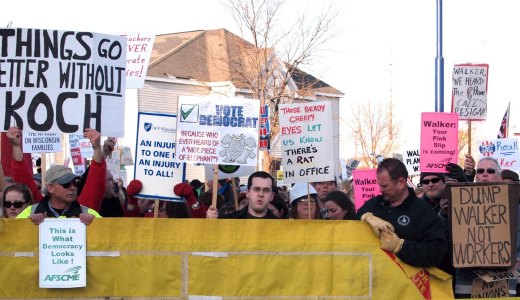
Some of the left in labor still seem to be stuck in the 1970s. It’s surprising how shallow some criticisms from the left can be when it comes to the labor movement. You really have to be wearing some kind of blinders to argue that Richard Trumka is essentially saying the same thing today that George Meany and Lane Kirkland said in their day.
In preface, I have great respect for Working In These Times and the work they do. But a recent article by Mike Elk really seems to me to illustrate what is wrong with too much of the left’s thinking on labor today.
In substance the argument goes something like: real political independence for labor hinges on making a clean break with the Democratic Party and willingness to withdraw almost all union support for Democratic candidates. Many in this mode go even further and argue that labor can only really be politically independent when they establish their own party.
But in the real world, labor political independence is far more than what candidate or party labor is supporting at a particular moment in time, place and circumstance. It is much more than labor not being critical enough of allies it disagrees with.
Labor’s political independence is not some arrived at moment of truth, a singularity type “ah-ha” moment when labor declares its political independence by blasting the Democratic Party and severing all ties. Instead, it is a process that ebbs and flows in tune with the political realities of the moment.
Labor has been developing its recent political independence ever since John Sweeney defeated the old guard Cold War remnant leadership in the 1995 election for president of the AFL-CIO.
Evaluating labor’s independence has to be firmly rooted in the reality of today’s all-out right-wing and corporate political attack on unions and democracy. And it has to be rooted in the incredible mass upsurge and fightback of labor, highlighted by the ongoing actions in Madison Wis., Indianapolis, Ind., Columbus, Ohio, and many other battlegrounds across the country.
Labor has been building up its own independent political action network since the late 1990s. Early on, this took the form of encouraging union members to run for office, mostly for local positions, with some success. Remember labor’s 2000 by 2000 campaign? Many of those union members elected in that period are still in office and still active in labor’s electoral work. Many of these candidates and their campaign workers developed skills for election work that they are passing on to new generations of union members.
The process very much deepened in the 2006, 2008 and 2010 election cycles. Union political action more and more takes the form of working on campaigns out of union halls, instead of Democratic Party offices. This is important because it means that unions build their own activist lists and mobilization techniques. It means deepening ties with rank-and-file activists. It means that unions spend their election money on mobilizing and training members rather than just sending money and troops to the Democrats to organize. Increasingly, labor spends it money on their own phone banking systems and other tools for political work.
Further unions develop their own themes and issues in voter education and getting out the vote. As someone who has spent a good deal of time at this level of work in my union and in other, similar labor efforts over the past 20 years, I can say that what union members and leaders are learning is very much political independence. Talk about not having any illusions about the Democratic Party.
It is particularly bothersome that the article caricatures Richard Trumka as “talking loud and saying nothing.” For sure, labor’s independence is uneven. For sure, you can find examples of old thinking in some labor leadership. But Trumka? I don’t think so.
Labor independence is not a thing in itself, isolated from other key issues of the class struggle. Take class unity. In the 2008 election Trumka took on racism and class unity in a way that hardly any Democratic candidate would ever even consider. I was at the United Steelworkers convention when Trumka made his impassioned pitch for unity in electing the first African American president in our history. Yes it was loud; more importantly it was profound and moved thousands of workers.
With that speech the AFL-CIO used the 2008 election as a teaching moment for all of labor. It became a moment that deepened labor’s understanding of basic class unity issues that went far beyond just the election.
Can anyone seriously argue that class unity is not a critical element of developing working class political independence? Sure, this was in the context of a Democratic Party candidate. But comes the time when labor has helped build a broad enough labor and class based coalition, strong enough to actually elect a labor/progressive candidate outside the two-party system and contend for power, Trumka’s speech will have been one of the key milestones in achieving the necessary political independence.
Lastly, let’s get real about the actual electoral situation on the ground. Overall, the AFL-CIO has shown great political and tactical maturity in the face of the big business assault. No element of society has been more disappointed by the lack of support for key parts of a labor agenda like the Employee Free Choice Act, health care reform and some aspects of economic policy. But standing on the sidelines throwing pure and polished critical stones is not a workable alternative.
No, labor has to contend with the actual balance of power and put pressure where it can make a concrete difference. Sometimes in the class struggle you actually have to fight defensive battles. Sometimes aiming your fire at imperfect allies, rather than the real source of your troubles, just weakens the coalition and strengthens your enemy.
Labor today is championing the most progressive agenda it has put forward since the formation of the CIO. Actually building the strength to win it will take building a much larger labor movement and a much broader working-class-led coalition.
Labor’s allies and labor partisans need to be fully onboard, to have any real influence.
CORRECTION: In a previous version of this story, the author of the article was misidentified. We regret the error.









